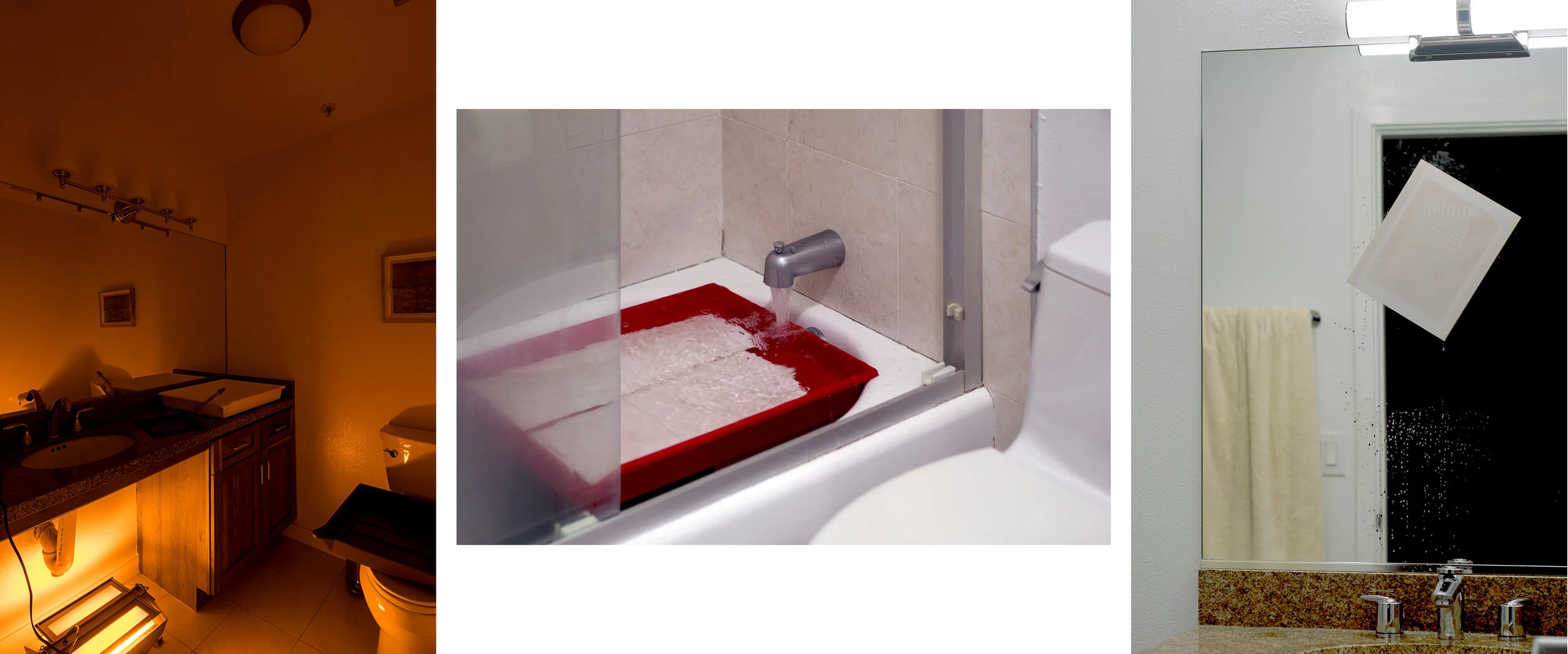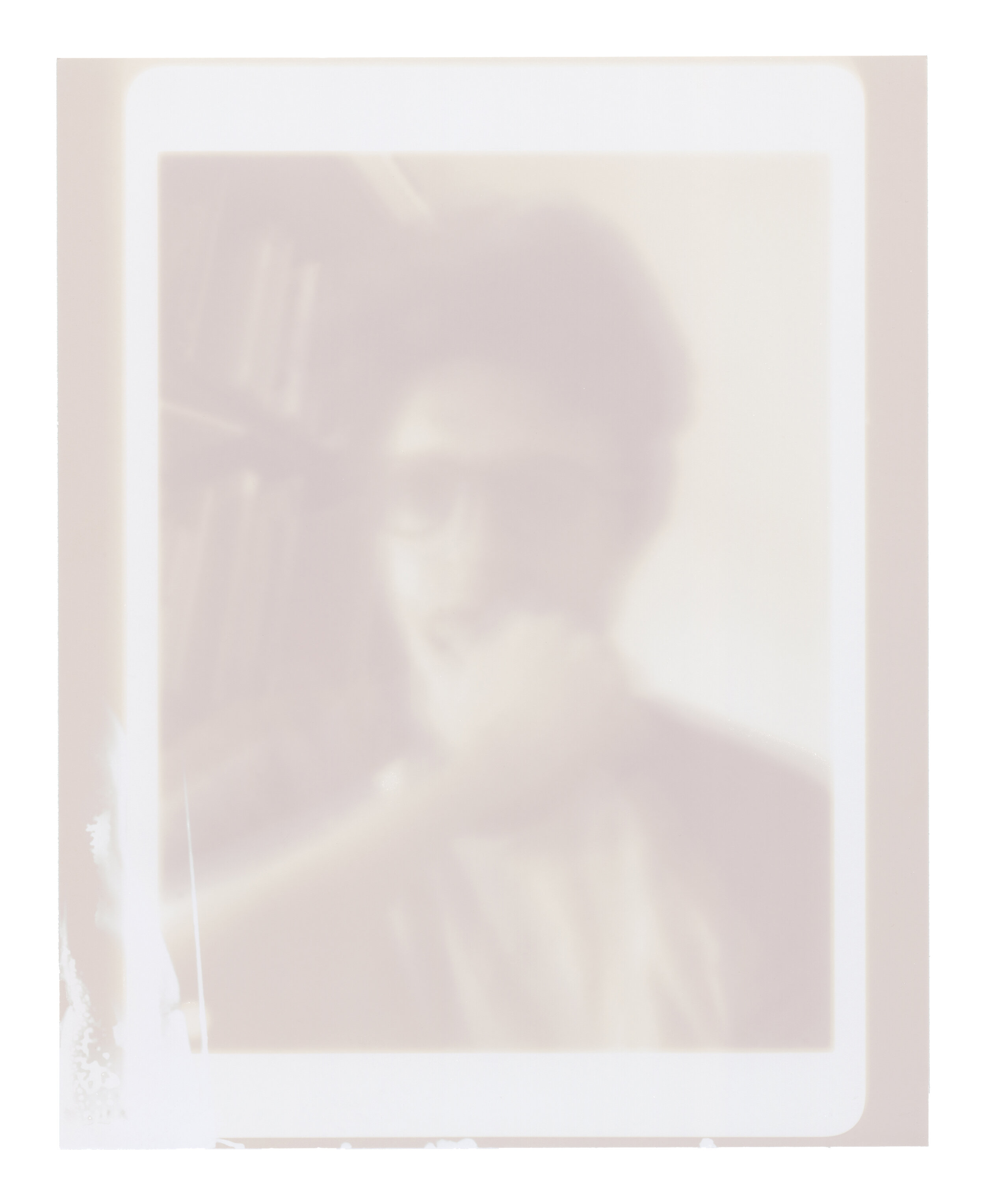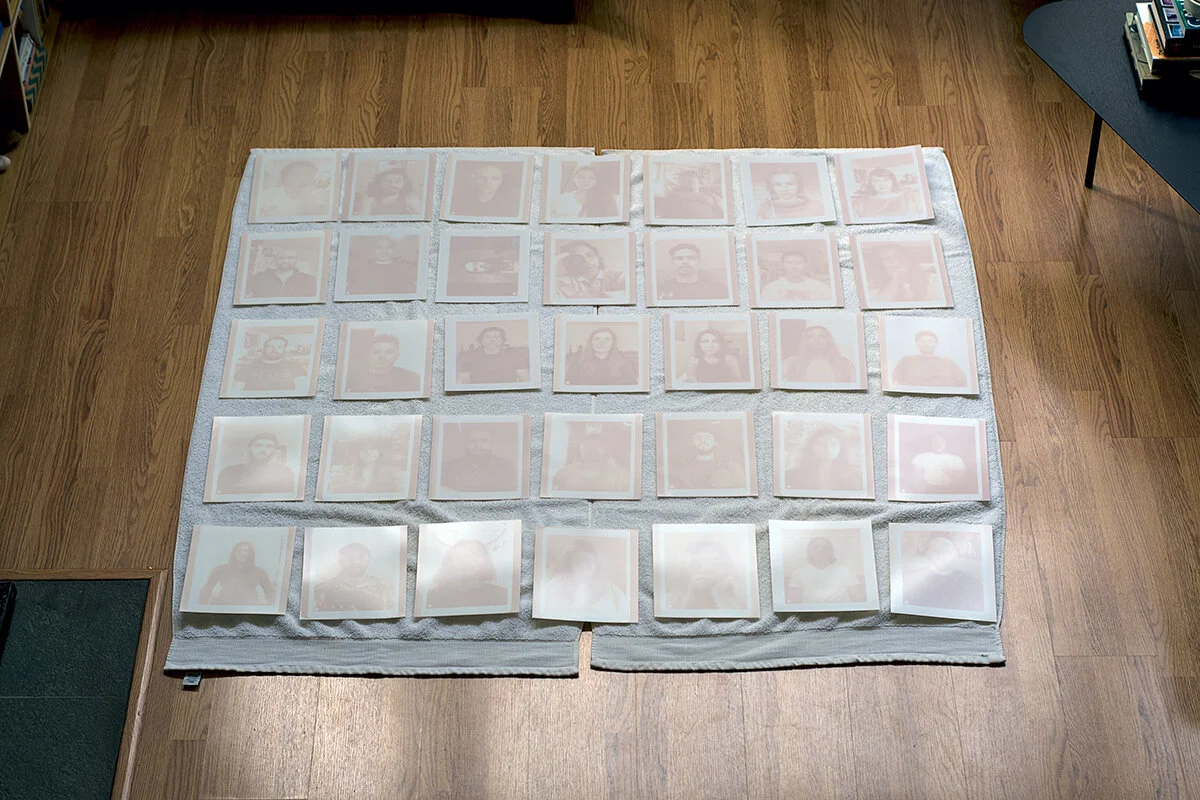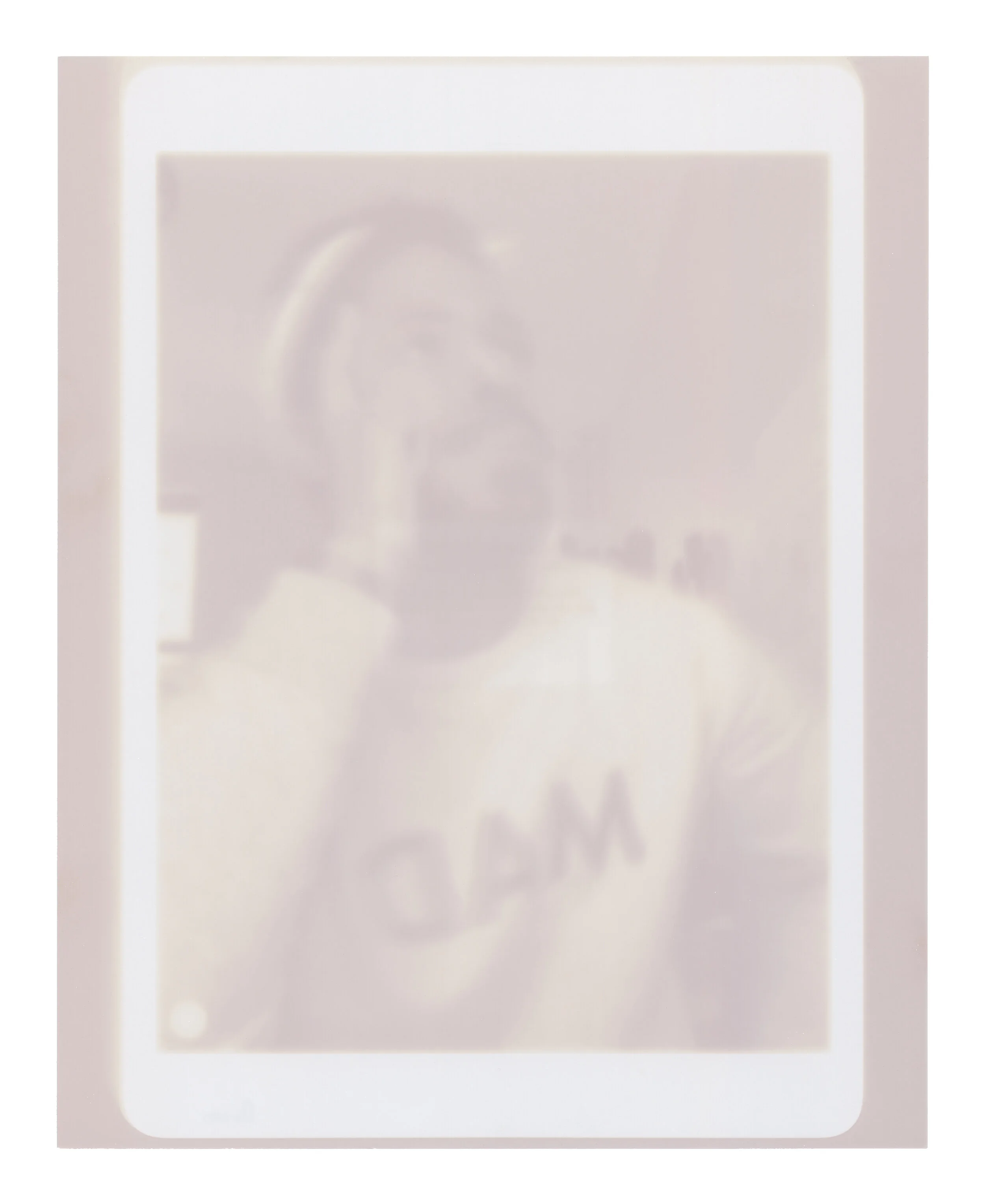Self Portrait – 04.24.20 San Francisco, CA
“It’s just a matter of time.”
Audio: Disorder – Joy Division
Robert Canali stages virtual photo sessions with home-bound friends, colleagues, and total strangers to understand communication and intimacy in the age of social distance.
In the weeks following social distancing, photographers around the world sought a creative and sincere way to respond. The New York Times ran a haunting piece on some of today’s most famous photographers including Stephen Shore, Catherine Opie, and Rinko Kawauchi looking out (and in) at their changing worlds. A day earlier, Lenscratch produced a compelling group show of emerging photographers called Quarantined Life and countless other curators and galleries have followed suit.
Midway through April, San Francisco-based photographer Robert Canali began Screentime, one of the most distinctive and unexpected photographic responses so far. Moved by the virtualization of social interactions, he started using one of photography’s earliest processes – the late 19th-century technique of lumen prints – to make portraits over Zoom.
Rather than photographing with a drone, like many commercial photographers have been doing for remote brand work, Canali sets up a Zoom call with friends and strangers, and places light-sensitive photo paper on his iPad. Before the photographic session begins, he asks his sitters a series of questions ranging from “How has the Pandemic changed your life for the worse”, “Has anything in your life improved?”, and “Is there anything about life, when it returns to a “new normal” that you think will be changed permanently?” (see image captions below for the responses).
Then he goes silent. His subjects hold still for 15 minutes while listening to a playlist of their favorite songs as the paper slowly absorbs their image. When the “photoshoot” is complete, Canali develops the paper in his studio darkroom. The images are often slightly blurry and signal the growing space between peers and the waiting game to return to reality. The further you stand from them, the sharper they appear.
Canali’s approach is meditative and conceptual and plays with old and new technology as a metaphor for our shifting and confused relationship to time.
Shortly after participating in one of his early sessions (thanks to Efrem Zelony-Mindell for introducing us), we reconnected to talk about the process and his ideas behind it.
Jon Feinstein in conversation with Robert Canali
Ashley – 04.30.20 Toronto, ON
“There is no way to deny the vast disparities and inequities between us all after this.”
Audio: Diddy Bop – Noname, Cam O’bi, Raury
Sarah - 04.15.20 Toronto, ON
“Went for lunch with colleagues at a shitty restaurant. Knew shit was getting real so had a bunch of shots, and that was my last social encounter.”
Audio: Hasn’t Hit Me Yet - Blue Rodeo
Jon Feinstein: Who was the first person you "photographed" for this series and why?
Robert Canali: The first person I captured was my good friend, Sarah. She’ll tell you she saved my life once, but that’s a story for another time. If I’m being honest, she was one of the first people I asked because there was a high probability that she would agree to participate, and I’d been trying to get her to FaceTime with me for weeks! She’s also one of my favorite people of all time and has a true appreciation for art. Not to mention she’s a ruthless critic with no filter, so I knew I could count on her to tell me if this was a shit idea.
Kat - 06.26.20 Oakland, CA
“Non verbal queues are permanently altered.”
Audio: Piano Sonata No. 13 in A Major - Franz Schubert, Sergei Tarasov
Feinstein: How did you come up with the idea?
Canali: This concept revealed itself organically. I wasn’t looking for a project or trying to think about making work. In fact, I’d started to embrace the idea of not having to be productive during quarantine and was starting to come to terms with not being able to visit my studio or have access to the facilities I would typically rely on to make work. In many ways, this project began as a response to those limitations and the drastic shift in the way we navigate our everyday life. In considering what I didn’t have I was able to reimagine the things that were available to me and the tools we use in order to maintain some semblance of normalcy, such as our smart devices and web conferencing.
I began taking an inventory of my own materials, things I had on hand in my apartment, and tried to consider what could come of them. I discovered that I have a lot of expired B&W photo paper – some might say I have too much, but I’d argue otherwise. Thinking about the paper reminded me of the lumen print process, a process I’d explored extensively for a project in 2017. I remember looking at my tablet and thinking, if I invert the screen it transforms the device into an illuminated negative, and if I place it face down onto a sheet of photo paper it should expose and produce a positive print. In that moment I realized I could replace the darkroom with nothing more than a tablet and photo paper. From there I began experimenting and thinking of what to record with this process.
What it looks like being interviewed and “exposed” by Robert Canali
The process revealed: behind the scenes in Robert Canali’s bathroom darkroom
Jon – 04.24.20 Seattle, WA
“If I could go to the zoo with my daughter right now....”
Audio: Punk as Fuck – The American Analog Set
Feinstein: Why is the lumen process so important to this?
Canali: This process is important for many reasons, namely because it allows me to record this unique connection between two very different technologies, creating an everlasting imprint of where the paper and screen touch. Through paper, light, and time, I can capture these shared experiences by exposing the live video feed through my tablet screen directly onto a sheet of silver gelatin photo paper. This technique hearkens back to the advent of the paper negative and portraiture in photography, whereby a long exposure was made resulting in a unique record of that moment. The subsequent print becomes the only memento of the time we share throughout this process.
Another important byproduct of this process is that my subjects are not victim to the photographer's gaze during the exposure. In fact, it is their own gaze that they're left to consider as they sit motionless and stare back at themselves through the screens of their device during the exposure. What results is an image that is more considerate of the person being captured instead of the person capturing it. This is an exercise in trust. The artist must trust their materials and subject's stillness, while the subject must trust that their patience and effort will not be in vain. It is this shared experience that I'm after.
Drying the prints
Left: Melissa – 04.29.20 Brooklyn, NY
“We went to Medieval Times and it was everything I wanted it to be and more!”
Audio: Gotta get Up – Harry Nillson
Right: Sam – 04.29.20 Brooklyn, NY
“I guess the handshake is probably toast.”
Audio: Wait – The Beatles
Feinstein: There's something incredibly metaphoric about the concept and process of "holding still" / for their prolonged exposure. In my mind, it reflects a stillness of our moment, of being frozen, of hanging in anticipation, maybe dread, maybe something else. How important is this to you/ how you think about this work?
Canali: The participant’s stillness is very important from a conceptual standpoint. While the subject’s stillness largely dictates how clear or “sharp” the image will be, I’m not looking to make the perfect portrait in any of these. There is not one more successful than another. I’m interested in the “in-between” moments, the moments we cannot control. The work comes to life when I turn the tablet over onto the paper and we both listen and wait in stillness in anticipation of something happening. I am simply creating the conditions for that something to occur.
The paper records every breath and subtle shift of the figure on screen and during that time there is nothing either of us can do to alter the results. This duration-based exposure echoes our current state, with each day melting into the next and the concept of time collapsing in on itself. For the first time in our lifetime, we have all been asked/forced to wait. Our patience is put to the test in hope of change. This virus and project do not discriminate based on social stratification. The stillness that we share throughout both processes is universal and prescribed with the best intentions. Like these portraits, only time can reveal the results of our efforts.
Darien – 05.16.20 Brooklyn, NY
“I have come to appreciate what I give to the world. I’m able to look at my contributions through a new lens.”
Audio: Midnight Blues – Umi
Serrah – 05.02.20 Seattle, WA
“Today was my son’s first birthday. Friends came to our yard in 20 minute intervals to celebrate at a distance. When they would leave there was no physical closure.”
Audio: Heavy - Birdtalker
Feinstein: You've photographed hundreds of people at this point. The first 100 took place over a couple of weeks. Can you tell me a bit about how that experience has been for you?
Canali: Intense, emotional, exhausting, and deeply meaningful. Something I couldn’t fully appreciate when this began was that I would be fortunate to meet so many wonderful strangers in a time when it’s otherwise forbidden to meet new people. Having said that, I underestimated my own emotional bandwidth. During each session, I ask the participant to share their thoughts and feelings about these trying times through a series of questions.
I feel responsible for unearthing these sentiments and don’t take that responsibility lightly. While not without its challenges, this has since become one of my favorite parts of the process. This project has also helped me become more organized and methodical in my process. Expose, process, scan, repeat – this has become a full-time job, seven days a week. I must be diligent to ensure that I don’t get overwhelmed.
It also seems crazy to me that I’ve made over 200 portraits because I’m not a portrait photographer by any stretch of the imagination. I’ve always struggled with the performative aspects of it. There’s a certain expectation for both artist and subject when making a portrait. They’re both seeking something for themselves and each other. The artist in pursuit of some sort of truth or beauty, and the subject, aware of this pursuit, might feel responsible for its success.
Left:Anastasiia – 04.30.20 Etobicoke, ON
“The weather was grim, grey, and windy.”
Audio: НИИ – Працтал Фрактал
Right: Allison – 05.16.20 Lenexa, KC
“That was the beginning of March and I haven’t seen anyone since”
Audio: Nobody – Mac DeMarco
Tristan – 05.01.20 Toronto, ON
“People’s trust will probably change forever.”
Whack World – Tierra Whack
Feinstein: With the high volume you've been working with, I imagine there have been some universal threads between sessions, between people's interview responses, between how they engage with the camera...care to share any commonalities?
Canali: Hope and fear are the most prominent themes and shared sentiments. I wish I could get all the participants together in one room or on one Zoom call for them to share their stories and realize just how similar we all are. This moment in our lives further emphasizes our sameness, and though it keeps us apart physically it unites us in that way. There are many that long to embrace and wish for nothing more than the opportunity to hug a loved one, but in that same breath wonder if the idea of a hug will be taboo by the time that’s an option. Others wish to travel, some to a movie theatre and some around the world, but all with the same looming sense that it will be different or forbidden. These bittersweet sentiments have become a familiar response in every session. We share many laughs and an equal number of deep sighs and long thoughtful pauses.
Michele - 05.28.20 Toronto, ON
“I’ve lost fear and found security.”
Audio: Queen of Denmark - John Grant
Gary - 06.16.20 Toronto, ON
“We’re at the height of the fight against racism”
Audio: Saddle In The Rain - John Prine
Feinstein: Music is such a big piece of this. In my own experience being “photographed,” it added to the hypnotic, dreamlike quality and got me comfortable. Why was this important to you and your process?
Canali: The music selection has been a wonderful part of the entire process and seems mutually beneficial. Some people curate deeply meaningful playlists while others shoot from the hip, but we collectively enjoy the moment they hit play. In that moment I feel like I learn more about the person on the other side of the screen than I could with an infinite number of questions. I sometimes feel bad that I get to dance to their music while they sit painstakingly still.
Daniel & Nori – 05.10.20 Toronto, ON
“This is the first time in eight years that you haven’t been traveling every two weeks.”
“Daniel has been sleeping better as a result.”
Audio: Juicy – Notorious B.I.G
Pedro – 04.27.20 San Francisco, CA
“It was a hint of what was to come.”
Audio: Coming Down From Outer Space – Acid King
Feinstein: Did you have a favorite song or playlist?
Canali: That’s a tough question! There have been so many great tunes and thoughtful playlists. Not to be a total cop-out but I’ve enjoyed them all, even the music I wouldn’t typically listen to or consider for my own playlists. Then again, this isn’t your typical listening experience. I can say that it’s been a great way to discover new music, it’s like a sneak-peek into someone’s top five list. One playlist/band that stands out is one that I can’t even pronounce the name of, працтал фрактал, the participant told me it translates to Praztal Fractal. They’re a young Russian Hip Hop group. We listened to a few tracks off their album, TAPE II, and while I may not speak the language, I can appreciate that their sound is amazing! Their music can be found on Spotify, Apple Music, YouTube, and Instagram.
Chelsea – 04.25.20 Lethbridge, AB
“My mental health has improved and with it my confidence.”
Audio: Stuck on The Puzzle – Lily & Madeleine
Rakhee – 04.23.20 Toronto, ON
“Taking a selfie at work.”
Audio: Nobody – Mitski
Feinstein: Did you observe any common challenges?
Canali: Everyone has responded differently to the sitting still part of the process, but one common struggle has been the idea of having to stare at yourself for the duration of the exposure. Participants have the option to position their eyes in any direction, but many choose to stare at the screen. While this task may sound simple, most have found it quite challenging and even uncomfortable at times. One person shared that their feelings about the way they look changed during that time. They began by critiquing the features that they dislike, and by the end felt ashamed for bullying themselves and saw those same features as beautiful, unique, and empowering.
Brandon – 05.07.20 Atlanta, GA
“Honestly, bullshit! This existential terror has made us let go of the bullshit.”
Audio: Sacred Space – Radha
Feinstein: What have been some of the most profound or revelatory moments for you in making this project?
Canali: Frankly, all of it! I was thrilled when the first print came out of the fix (the photographic chemical used to stabilize the image) and the image was still there. I was equally excited to see that the subject was framed by the tablet screen which appears as a white border around the image. This tasteful artifact of the technology used to create the image helps tie the “very then” to the “very now”. I love that the prints don’t immediately read as what they are. Many have assumed that they’re Polaroids or digital images that have been manipulated to look antique or strange.
All this is to say that much of this process has been a genuine and pleasant surprise, especially the willingness of the strangers who have participated. This project represents a unique milestone in my practice, granting the opportunity to collaborate on a global scale.
A common theme in my work is to relinquish control and embrace the unknown, and I’ve been able to relearn that through this project. It's a challenge as an artist to remove your hand or eye from the process and invite the opportunity for chance, but that is precisely what this work is about – the moments of uncertainty when our reality is called to question and there is little we can do to influence it. This project is my response to that call.




















